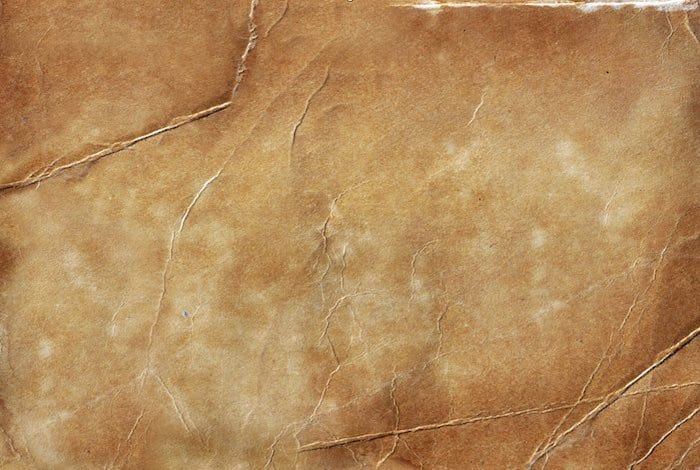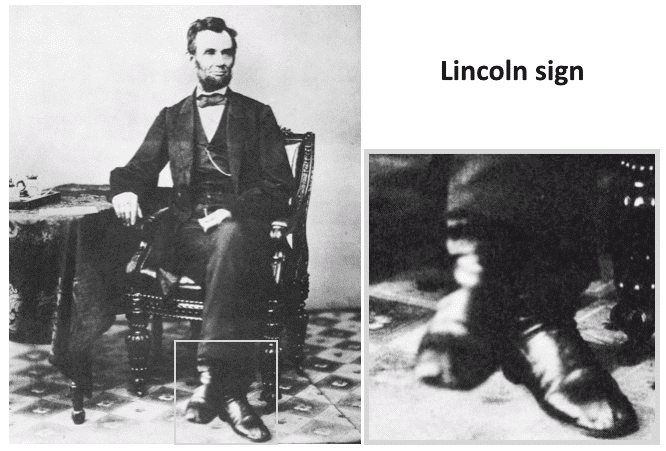Lincoln sign
Description
Lincoln sign refers to forceful popliteal artery pulsation secondary to aortic regurgitation; exaggerated when the patient sits with legs crossed; and deemed positive if the elevated foot bobs up and down with each systolic contraction.
Lincoln sign is based on a hypothetical diagnosis for Abraham Lincoln, the 16th president of the United States. First observed by Lincoln himself, and expounded upon by the journalist Noah Brooks in 1863.
History
1863 On Sunday, November 8, 1863 the famous “big foot” photograph was taken by Alexander Gardner in Washington. Lincoln noted that the outline of his left boot was blurred. The journalist Noah Brooks suggested that it was the throbbing of the arteries behind Lincoln’s knee that caused the leg to move almost imperceptibly.
One day we were looking at a photograph of the President, taken in a sitting position, with the legs crossed. Lincoln’s attention was attracted to the foot of the leg which was crossed above the other, and [Lincoln] said,
“Now, I can understand why that foot should be so enormous. It’s a big foot, anyway, and it is near the focus of the instrument. But why is the outline of it so indistinct and blurred ? I am confident I did not move it.”
I studied it for a moment, and told him that probably the throbbing of the large arteries in side of the bend of the knee caused an almost imperceptible motion. The President, very much interested in the discovery,’ as he called it, immediately took the position of the figure in the picture, and, narrowly watching his foot, exclaimed,
” That’s it ! that’s it! Now, that’s very curious, isn’t it.”
Noah Brooks 1878
1933 Cardiologist Sir Thomas Lewis described the quality of the pulse-wave of aortic incompetence:
All the pulses of the body jerk forcibly. The abdominal aorta throbs violently. As it travels, the pulse-wave rises more and more steeply and to a higher crest, and so it frequently happens that the abrupt jerking (or water-hammer) quality is extreme in the dorsum of the foot
Lewis 1933
1950 Cardiologist Aldo Augusto Luisada described the “arterial dance” associated with aortic insufficiency
…the abrupt rhythmic extension of one leg when crossed over the other coincident with systole.
Luisada 1950
1961 Abraham M. Gordon suggested Lincoln suffered from Marfan syndrome.
Abraham Lincoln was tall, loose-jointed, kyphotic, dolichocephalic, with unnaturally long, thin, arms and legs. The Marfan Syndrome, presumably inherited from his mother, is believed to explain Lincoln’s morphological appearance.
Gordon 1961
1964 Harold Schwartz provided further genealogical evidence of Marfanoid characteristics
The Marfan syndrome was found in a male descendant of Mordecai Lincoln II, great-great-grandfather of Abraham Lincoln. The common ancestry of the patient and the 16th president appears to establish genealogically that Lincoln’s unusual morphological characteristics were manifestations of the genetically determined arrangement of connective tissue described by Marfan in 1896.
Schwartz 1964
1972 Schwartz presented his theory that President Lincoln, two years before his assassination, had physical findings consistent with aortic insufficiency, as a complication of the Marfan syndrome.
Considering, then, the presence of the Marfan syndrome as previously established in Mr. Lincoln; the frequency of aortic valvular incompetency in that condition; the hemodynamics of aortic regurgitation; the graphic data of the Gardner photograph as detected by the President himself; the hypothesis of Brooks and its clinical confirmation by Lincoln…the evidence in the case of the President becomes highly consistent with aortic insufficiency and regurgitation.
Schwartz 1972
Associated Persons
- Noah Brooks (1830-1903), Journalist
- Abraham Lincoln (1809-1865), 16th president of the United States (1861-1865)
- Aldo Augusto Luisada (1901-1987)
- Sir Thomas Lewis (1881-1945)
Alternative names
- Lincoln-Brooks sign of aortic insufficiency
- Schwartz sign
References
- Brooks N. Personal reminiscences of Lincoln. Scribner’s Monthly 1878; XV: 565
- Lewis T. Aortic Regurgitation. In: Diseases of the heart, 1933: 120-126
- Luisada AA. Heart, A Physiologic And Clinical Study Of Cardio-vascular Diseases. 1954: 240-241
- Gordon AM. Abraham Lincoln–a medical appraisal. Journal of the Kentucky Medical Association. 1962; 60: 249-53
- Hamilton C, Ostendorf L. Lincoln in Photographs, an album of every known pose. University of Oklahoma Press, 1963: 146-147
- Editorial. The Strange Case of Abraham Lincoln. Br Med J 1964; 1: 858
- Schwartz H. Abraham Lincoln and the Marfan syndrome, JAMA 1964; 187: 473-479
- Schwartz H. Abraham Lincoln and aortic insufficiency. The declining health of the President. Calif Med. 1972 May;116(5):82-4.
- Cheng TO. Lincoln sign, the 14th eponymous sign of aortic regurgitation. Geriatrics. 2004 Sep;59(9):16.
- Cheng TO. Lincoln sign: second eponymous sign of aortic regurgitation named after a patient instead of a physician. Int J Cardiol. 2005 Aug 18;103(2):224.
- Kroen C. Abraham Lincoln and the ‘Lincoln sign’. Cleve Clin J Med. 2007 Feb;74(2):108-10.
- Zhang G. Eponyms in Aortic Regurgitation. LITFL 2019

eponymictionary
the names behind the name

